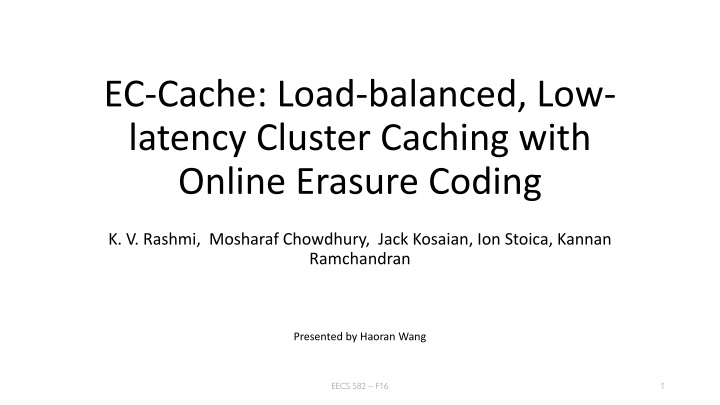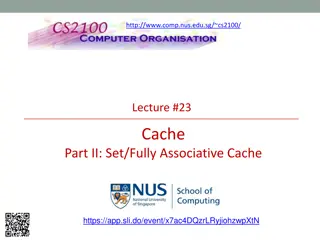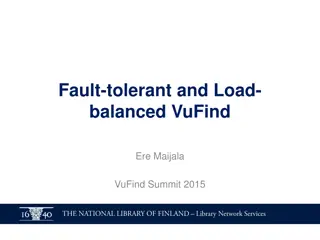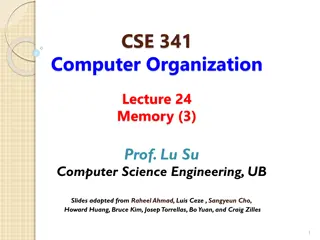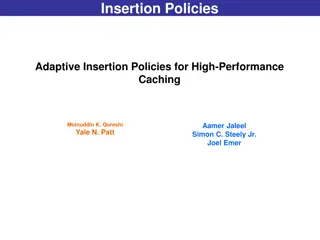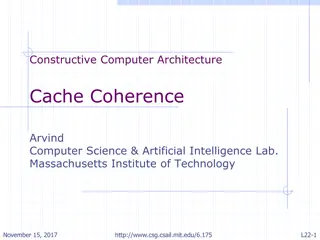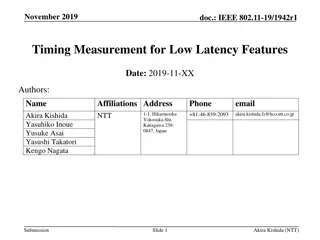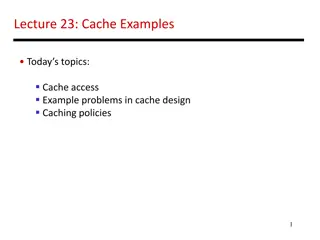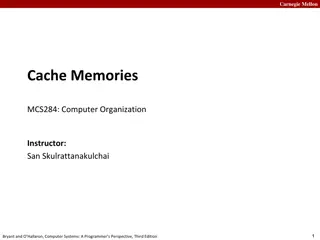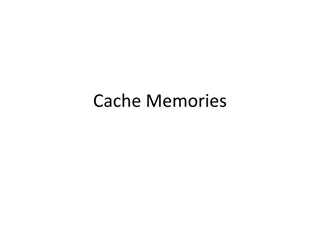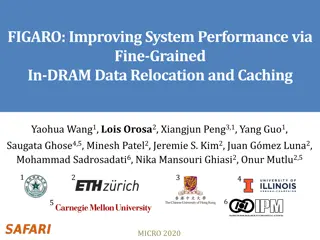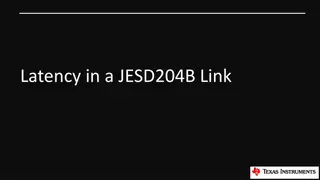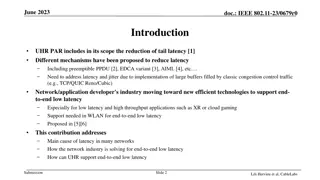EC-Cache: Load-balanced, Low-latency Cluster Caching
In-memory caching trends for object stores have led to a reduction in disk I/O, addressing load imbalance and network congestion. This study explores online erasure coding for fault-tolerance and space efficiency in cluster caching systems. Replication and fault-tolerance strategies are examined, including survivability against failures. Erasure coding techniques with linear parity and coefficients matrices are discussed, along with storage limitations.
Download Presentation

Please find below an Image/Link to download the presentation.
The content on the website is provided AS IS for your information and personal use only. It may not be sold, licensed, or shared on other websites without obtaining consent from the author.If you encounter any issues during the download, it is possible that the publisher has removed the file from their server.
You are allowed to download the files provided on this website for personal or commercial use, subject to the condition that they are used lawfully. All files are the property of their respective owners.
The content on the website is provided AS IS for your information and personal use only. It may not be sold, licensed, or shared on other websites without obtaining consent from the author.
E N D
Presentation Transcript
EC-Cache: Load-balanced, Low- latency Cluster Caching with Online Erasure Coding K. V. Rashmi, Mosharaf Chowdhury, Jack Kosaian, Ion Stoica, Kannan Ramchandran Presented by Haoran Wang EECS 582 F16 1
Background The trend of in-memory caching for object store Reduced a lot of disk I/O e.g. Alluxio(Tachyon) Load imbalance Skew of popularity Background network traffic congestion EECS 582 F16 2
Erasure coding in a nutshell Fault-tolerance in a space-efficient fashion Trade data availability for space efficiency EECS 582 F16 3
Replication X Y Z EECS 582 F16 4
Replication X Y Z Replica factor = 2 X Y Z EECS 582 F16 5
Erasure Coding X Y Z EECS 582 F16 6
Erasure Coding a11 a12 a13 + = + X Y Z W Linear parity = a21 a22 a23 + + X Y Z T EECS 582 F16 7
Erasure Coding a11 a12 a13 + = + X Y Z W Linear parity k = 3, r = 2 = a21 a22 a23 + + X Y Z T EECS 582 F16 8
Erasure Coding a11 a12 a13 + = + X Y Z W Linear parity k = 3, r = 2 = a21 a22 a23 + + X Y Z T A well-known co-efficient matrix: ?11 ?21 ?12 ?22 ?13 ?23 EECS 582 F16 9
Fault tolerance - Replication X Y Z Survived 1 failure X Y Z EECS 582 F16 10
Fault tolerance - Replication X Y Z Survived 2 failures X Y Z EECS 582 F16 11
Fault tolerance - Replication X Y Z Cannot survive X Y Z EECS 582 F16 12
Fault tolerance - Replication Total storage is 6 units Only guaranteed to survive one failure EECS 582 F16 13
Fault tolerance - EC a11 a12 a13 + = + X Y Z W Linear parity k = 3, r = 2 = a21 a22 a23 + + X Y Z T A well-known co-efficient matrix: ?11 ?21 ?12 ?22 ?13 ?23 EECS 582 F16 14
Fault tolerance - EC Translated into linear equations: ?11? + ?12? + ?13? = ? ?21? + ?22? + ?23? = ? ? = ? ? = ? ? = ? ? : the symbol that represents data ? ?: the actual value of ? EECS 582 F16 15
Fault tolerance - EC Translated into linear equations: ?11? + ?12? + ?13? = ? ?21? + ?22? + ?23? = ? ? = ? ? = ? ? = ? Still solvable, with unique solution (set) EECS 582 F16 16
Fault tolerance - EC Translated into linear equations: ?11? + ?12? + ?13? = ? ?21? + ?22? + ?23? = ? ? = ? ? = ? ? = ? 5 equations and 3 variables Can survive ANY 2 failures Because N variables can be solved from N (linearly independent) equations EECS 582 F16 17
Fault tolerance EC Need only 5 storage units to survive 2 failures Compared to replication: (6,1) EECS 582 F16 18
Whats the tradeoff? Saving space V.S. Time needed to reconstruct (solving linear equations) EECS 582 F16 19
Switch of context EC for fault-tolerance EC for load balancing and low latency Granularity: single data object splits of object How about the tradeoff? Deal with primarily in-memory cache, so reconstruction time won t be a problem EECS 582 F16 20
Load balancing 4 pieces of data: Hot Hot Cold Cold EECS 582 F16 21
Load balancing Seemingly balanced Hot Cold Hot Cold EECS 582 F16 22
Load balancing What if some data is super hot ? Super hot >> hot + cold + cold Hot Cold Cold Super Hot EECS 582 F16 23
Load balancing Introducing splits Distribute the hotness of single object Also good for read latency read splits in parallel EECS 582 F16 24
But whats wrong with split-level replication? Server 3 Server 6 Server 1 Server 4 Server 2 Server 5 X Y Z X Y Z EECS 582 F16 25
But whats wrong with split-level replication? Server 3 Server 6 Server 1 Server 4 Server 2 Server 5 X Y Z X Y Z Need at least one copy of (X,Y,Z) to retrieve the whole object EECS 582 F16 26
The flexibility of EC Server 3 Server 1 Server 4 Server 2 Server 5 X Y Z W T Any k (= 3) of k + r (=5) units would suffice to reconstruct the original object EECS 582 F16 27
EC-Cache: Dealing with straggler/failures Server 3 Server 1 Server 4 Server 2 Server 5 X Y Z W T Failed/Slow, but it s OK Read ? + ( < r) out of k + r units, finish as long as first k reads are complete EECS 582 F16 28
Writes Create splits Encode to parity units Uniformly randomly distribute to distinct servers EECS 582 F16 29
Implementation Built on top of Alluxio (Tachyon) Transparent to backend storage/caching server Reed-Solomon codes instead of linear parities Intel ISA-L for faster encoding/decoding Zookeeper to manage metadata Location of splits Mapping of object to splits Which splits to write Backend storage server takes care of ultimate fault-tolerance EC-Cache deals with only in-memory caches EECS 582 F16 30
Evaluation Metrics Load imbalance: ? = ???? ???? ???? 100 Latency improvement: ????????? ?? ??? ??? ??? ? Setting Selective Replication V.S. EC Zipf s distribution for object popularity Highly skewed (p=0.9) Allowed 15% overhead EECS 582 F16 31
Evaluation Read latency EECS 582 F16 32
Evaluation Load Balancing EECS 582 F16 33
Evaluation Varying object sizes Median latency Tail latency EECS 582 F16 34
Evaluation Tail latency improvement from additional reads EECS 582 F16 35
Summary EC used for in-memory object caching Effective for load balancing and reducing read latency Suitable workloads Immutable objects Because updates to any data units would require re-encoding a new set of parities Cut-off for small objects Overhead cannot be amortized still use SR for small objects EECS 582 F16 36
Discussions In EC-cache, there are extra overheads for encoding/decoding/metadata/networking, in what contexts can they be tolerated/amortized? What design would be good for frequent in-place updates? Any existing solutions? What policy could minimize the eviction of splits needed for current read requests? EECS 582 F16 37
